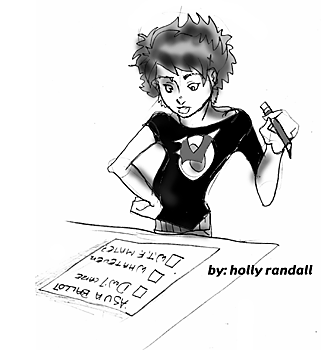
Illustration by Holly Randall
|
|
By Rui Wang
Arizona Daily Wildcat
Wednesday, March 23, 2005
Print this
Now that the ASUA elections are over and the numbers are in, it's time to engage in a little armchair analysis. You don't need to be a statistician to have a few figures jump out: ASUA voter turnout is surprisingly low and the number of women candidates that ran for ASUA president is extremely small.
Compare, for instance, ASUA voter turnout with the U.S. presidential election in November where an estimated 60 percent of eligible voters showed up. Here at the UA, turnout percentages for the latest elections hovered in the teens.
The good news about voter turnout on campus is that it's been steadily increasing in the past few years from a measly 2,032 voters in the 2000 election to 4,452 voters this year. The bad news is that this latter figure only represents about 16 percent of the entire undergraduate student body. The percentage drops almost into the single digits if you count the graduate and professional student population.
An analysis of the U.S. presidential election by the Committee for the Study of the American Electorate indicates that the relatively high turnout this year was fueled by polarized political divisions among voters. Similarly, the two ASUA presidential candidates this year elicited strong reactions among students. But you can't depend on polarizing candidates each year to raise the turnout. There are a few problem areas that, if solved, can boost participation.
Graduate and professional students vote in extremely low numbers. I'm not sure many of us are even aware that we can vote in ASUA elections. Increasing graduate participation in the elections process is another justification for bringing graduate students under the ASUA umbrella. Greater outreach into the graduate community would also help, because so few candidates bother campaigning outside of the main campus.
Erin Hertzog, a sophomore ASUA Senator and next year's executive vice president, suggests that setting up more computer polling booths around campus and at the Student Recreation Center would help combat voter apathy and laziness.
But Hertzog is not necessarily alarmed by the turnout rates. "To me, 10 percent of the student population is huge," said Hertzog. "College students have a lot on their minds... the people who do vote are people who get really into elections."
It is also shocking how few women run for president and how few become ASUA president.
In the primaries for ASUA president, there have been three female candidates out of 21 total candidates in the past six years. In that time, only one of the three candidates – Kristel Miller – has advanced to the general presidential election.
In the whole history of ASUA elections going back to 1913, there have been just four women presidents.
Where statistics are available, they seem to indicate that the demographics of the voters are split 50-50 between male and female students. So why the discrepancy among presidential candidates?
"Women don't run for president, because it's too hard to run around campus in high heels," joked Sara Birnbaum, a junior and the current executive vice president.
Could it be that, as Nicholas Kristof of The New York Times writes, "ambitious, high-achieving women are still a turnoff?" Kristof was referring to the improbability of a Hilary Clinton presidency, but ASUA may very well be a microcosm for the national picture.
Birnbaum agrees that the problem is more systemic than it is about sex: "We'd like to believe that we've moved on, but we (still) don't have a female president of the university."
The lack of female candidates is not evident among the other ASUA positions. For the offices of executive and administrative vice president, female candidates consistently run and win.
Birnbaum points out that the vice president position is not necessarily a stepping stone into the presidency at ASUA. In addition, women may take supporting roles in government because the confluence of power and responsibility is an area that still makes many women squirm.
Hertzog, who has been involved in ASUA since her freshman year, seems like an ideal candidate for president in the next election, but she's not sure if she'll run. When asked why women don't run for the position more often, she said, "I think it's just an insecurity. I think people just think they can't, that a male will do better... people just kind of assume that someone on ASUA who is male is going to run."
In order for those perceptions to change, change must percolate from the bottom up. That's why it's important that women on college campuses view executive positions as attainable and desirable: As women become more present in boardrooms, student governments, academia, and legislatures, the presidency of the United States can't be far behind.
Both low voter turnout and the lack of women candidates are representation issues, possibly correlated, that are hard to overhaul but should be improved in order for ASUA to be a more effective student government.
Rui Wang is a third-year law student. She can be reached at letters@wildcat.arizona.edu.
